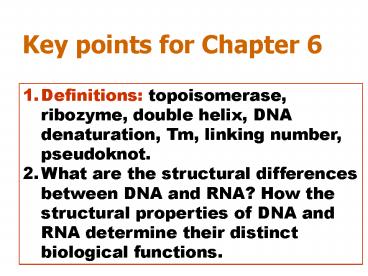Key points for Chapter 6 PowerPoint PPT Presentation
1 / 19
Title: Key points for Chapter 6
1
Key points for Chapter 6
- Definitions topoisomerase, ribozyme, double
helix, DNA denaturation, Tm, linking number,
pseudoknot. - What are the structural differences between DNA
and RNA? How the structural properties of DNA and
RNA determine their distinct biological
functions.
2
Key points for Chapter 7
- Definitions nucleosome, gene density, core
histones (structure and function), Nucleosome
remodeling complexes - Describe the important functions of packing of
DNA into chromosome. - Why genes make up only a small proportion of the
eukaryotic genome.
3
Key points for Chapter 7
- Briefly describe roles of three critical DNA
elements important for chromosome duplication
segregation - Briefly describe how the higher-order chromatin
structure is formed
4
Key points for Chapter 8
- Definitions replication fork, leading strand,
lagging strand, Okazaki fragment, processivity,
proofreading exonuclease, replisome,
pre-replicative complexes (pre-RCs) - Describe the function and mechanism of DNA
polymerase. - Describe DNA replication process and proteins
involved at a replication fork.
5
Key points for Chapter 8
- How is the DNA replication tightly controlled in
E. coli and in eukaryotic cells? - What is the end replication problem? how does
cell resolve the problem?
6
Key points for Chapter 9
- Definitions replication errors, spontaneous DNA
damage, DNA mutations, double-strand break (DSB)
repair pathway. - How does the mismatch repair system accurately
detect, remove and repair the mismatch resulting
from inaccurate replication? - What are the environmental factors that cause DNA
damage?
7
Key points for Chapter 9
- How could a DNA damage be converted to DNA
mutation? - What are the mechanisms to repair a DNA damage?
Describes how base excision and repair and
nucleotide excision repair work? - What is translesion DNA synthesis? Why it is
important?
8
Key points for Chapter 10
- Definitions Mating-type switching, gene
conversion, Holliday junction - Compare the two models for homologous
recombination, which model finds more evidence? - Describe RecBCD pathway and protein involved in
bacteria, and the function of the eukaryotic
homologue Spo11, MRX and Dmc1
9
Key points for Chapter 11
- Conservative site-specific recombination (CSSR)
definition, consequence, mechanism and examples. - Transposon and transposition definitions,
consequence, basic structural feature of three
principle classes of transposable elements, and
the mechanism of viral-like retrotransposons/retro
viruses
10
Key points for Chapter 12
- The central dogma,
- Transposon and transposition definitions,
consequence, basic structural feature of three
principle classes of transposable elements, and
the mechanism of viral-like retrotransposons/retro
viruses
11
Key points of chapter 12
- RNA polymerases (RNAP, ????????) and
transcription cycle - Transcription cycle in bacteria
- Initiation (1) promoters and promoter
recognition by s factor (4 domains) and aCTD. (2)
Transition from the closed complex to the open
complex. (3) abortive initiation. - Elongation and proofreading by RNAP
- Termination Rho-independent and Rho-dependent
mechanism
12
- Transcription cycle in eukaryotes
- ---RNAP II transcription
- Initiation (1)Promoter and its recognition by
GTF, (2) Assembly of the pre-initiation complex,
(3) Initiation in vivo requires additional
proteins____ - Elongation (1) phosphorylation of the CTD tail
of RNAP II, shedding most of its initiation
factors, and recruiting factors for elongation
and RNA processing. (2) How RNA processing is
coupled with transcription? - Polyadenylation and termination
- ---RNAP I and III transcription
- GTFs and promoter recognition
13
Key points of chapter 13
- Definitions exons, introns, RNA splicing,
spliceosome alternative RNA splicing, exonic
splicing enhancer, SR proteins trans-splicing
alternative spliceosome RNA editing, ADAR
enzyme, guild RNAs - The chemical reaction of RNA splicing
- Describe the splicing pathway conducted by
dynamic spliceosome assembly - Self-splicing introns and chemical reactions
- How alternative splicing is regulated?
14
Key points of chapter 14
- The main challenge of translation and the
solution - The structure and function of four components of
the translation machinery. - Translation initiation, elongation and
termination (????????????) - The mRNA and protein stability dependent on
translation (????????,?????)
15
Key points of chapter 15
- Definitions codon, degeneracy, synonyms,
missense mutation, nonsense mutation, frameshift
mutation, suppressor gene - What is the wobble concept?
- What are the three rules governing the genetic
code? - What are the benefits of the code universality
(P475)?
16
Key points of chapter 16-17
- Principles of gene regulation. (1) The targeted
gene expression events (2) the mechanisms by
recruitment/exclusion or allostery - Regulation in bacteria
- ---transcription initiation the lac operon,
alternative s factors, NtrC, MerR, Gal rep,
araBAD operon - ---after transcription initiation the trp
operon, riboswitch, regulation of the synthesis
of ribosomal proteins
17
- Regulation in eukaryotes
- --- Definitions regulatory sequences, enhancers,
insulators, gene silencing, ChIP, two hybrid
assay, LCR, - --- Describe the similarity and differences of
regulation between eukaryotes and prokaryote - --- Describe the DNA binding domains and
activating regions that eukaryotic activators
commonly use. - Regulation at transcription initiation
- ---Describe the two ways that eukaryotic
activators recruit polymerase.
18
---How signals are integrated by the function of
activators (F17-14)? Give two examples. ---Describ
e the ways in which eukaryotic repressors work
(F17-19) ---Use an example to illustrate that
signals are often communicated to transcription
regulators through signal transduction pathways
(F17-21) Regulation after transcription
initiation --- Use an example to illustrate
regulation of alternative mRNA splicing
(F17-28) RNA in gene regulation ---Describe the
production pathway and the function of siRNA and
microRNA
19
Key points of chapter 19
- Definitions cloning vector, expression vector
shotgun sequencing, comparative genomics,
proteomics, mass spectometry (MS) restriction
endonuclease, Northern hybridization, southern
hybridization, Western blot, PCR affinity
chromatography, gel filtration chromatography,
ion exchange chromatography, SDS PAGE. - How to clone a gene, to screen for the
recombinant plasmid-containing colonies, to
express a gene, and to purify an encoded protein? - How to create a genomic DNA and a cDNA library?

